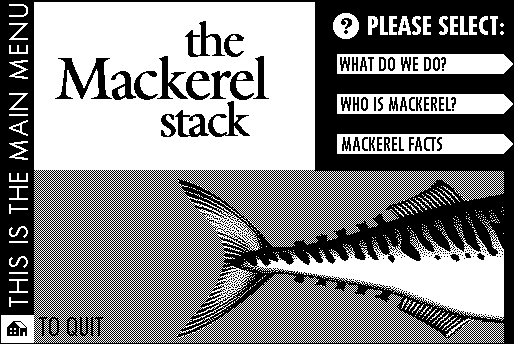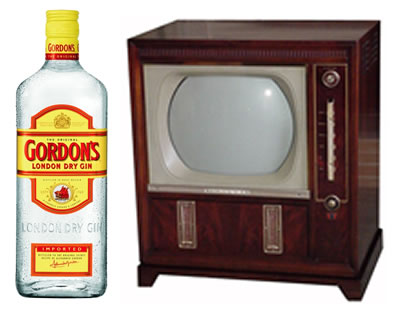
After emerging from a colorful academic career at Crazy Go Nuts University with a computer science degree at the end of 1994, I steered away from the opportunities available to a junior developer at the time — maintaining mainframe and minicomputer software for banks, insurance companies, and other large enterprises — and instead joined an upstart company that paid its employees $12.50 an hour to make multimedia applications.

The company was called Mackerel Interactive Multimedia, and they’d made a name for themselves in the design community by making some of the most clever interactive brochures and kiosks of that era, and were starting to take on bigger clients. You have to remember that this was back when many computers didn’t have sound cards, never mind CD-ROM drives and modems, and Netscape had just released the 1.0 version of this new software called a “web browser”.
Mackerel’s goal was to make the next Myst or similar multimedia hit. In order to pay the bills while we worked towards that endgame, we made multimedia apps for clients. These were typically interactive advertising or educational pieces that would eventually be distributed on CDs or even multiple floppy disks. As the company’s chief programmer (I was the only one out of a couple dozen rank-and-file employees who had a computer science degree), I’d be brought into meetings with the clients. That’s where I had my first brush with the music industry in its pre-Napster state.
One day during the summer of 1996, one of the founders came into the developers’ bullpen and announced that we’d landed a contract with an independent record label belonging to a major record company.
“Isn’t that a contradiction in terms?” I asked.
Apparently it wasn’t. The label turned out to be a new branch of the major record company that presented itself as an indie for street cred with both its acts and the music-buying public. In spite of their Hot Topic-level authenticity, we thought they’d make an interesting client, and the money was too good to pass up.

The exec that the label sent to visit was a woman who gave off more of a business school vibe than a rock vibe. She peppered her speech with business-school-isms like “target audience” and “units sold”. She used the word “product” several times, and I don’t recall her using the word “music” or even “album” once. It seemed that everything she knew about music didn’t come from being a fan; it came from what she’d read in market research reports.
“That’s why they don’t call it show art,” one of the creative directors quipped.

One of the goals of this initial meeting was to brainstorm some ideas for interactive apps that we could build for them.
I’d been working on an idea that I was rather proud of: CD player apps customized for specific albums. For any CD other than the one for which it was customized, it would show a mostly plain interface, plus some promos for the album. However, if you used the player to play the album for a specific album, it would “come alive” with the album’s lyrics, liner notes, album art and so on. It was an attempt to bring back what was lost in the move from LPs to CDs.
“Nice try, kid,” said the exec with great disdain. “We did some market research and we’ve determined that no one will ever listen to music on their computer.”
“People see them as machines for getting work done. We’re aiming for the rec room, the den, the living room and the bedroom, not the home office. You computer guys are aiming for home office.”
“You sure about that?” our production manager asked. “We all use the CD players on our machines. For some of us, our computers are in our bedrooms and living rooms, and they’re also our primary stereos now.”
“That may be true for you,” she replied, “but you guys are the exception. Computers are great, but they’re office equipment. You don’t keep a typewriter or photocopier in your living room, so why would you have a computer there? And that’s where people listen to their music. Office equipment and entertainment: apples and oranges.”
“Trust me – I’ve been in the music industry for a while – no one’s going to listen to music on their computer.”
Other people at the meeting presented their ideas, and she shot them down as well, with the same dismissive contempt.

At some point during the increasingly futile brainstorming session, I remembered something that I’d brought back from the Macromedia User Conference. I reached into my laptop bag and fished out a floppy disk.
“Here, check this out,” I said, slotting the diskette into my laptop. “It’s something called Shockwave, which lets you embed multimedia applications inside web pages.”
“We don’t think there will be much interest in the world wide web outside of technical people. The pictures are tiny, you’re stuck with default fonts, and your customers have to go buy a modem. Too much tech hassle, too little payoff.”
“You should give this a look,” I insisted. “The company that makes the tool we use to write multimedia software is using MPEG-1 layer 3 [the term “MP3″ hadn’t made common parlance yet] compression to squeeze music files into less space. There’s a small multimedia program on this floppy, and a whole three-minute song. It would normally take about 8 floppies to hold this song.”
I put the disk in my laptop and launched the Shockwave application, which started a tune playing.
“Sounds like crap,” she said. “And who’s the band? The Spin Doctors? They’re so over.”
“Ignore the band,” I said, trying to remain patient. “Just think of the possibilities. This three-minute single is only a megabyte in size. It fits on a floppy, which you can hand out, or you’d be able to download it in a reasonable amount of time. The download will be even faster on the new 56K modems.”

“Blah, blah, blah,” she said, making that opening-and-closing hand gesture signifying pointless chatter. “It only means something to you because you’re a techie. I’ve seen the market research, and I will tell you now:
People are not going to be getting their entertainment from computers or the internet. It’s going to come from set-top boxes and MiniDisc recharging stations at their record stores.”
At this point, I decided that discretion was the better part of valour. “Well, you seem to have all the market research, so maybe the best thing would be for you to come up with ideas for an interactive application, and then we can hammer out the details with you in a later meeting.”
“I think that would be a good idea,” she said. She rose from her seat to leave the room, shaking her head.
“I don’t know about you,” I said to the others after confirming that she was out of earshot, “but I think the music industry needs to be destroyed.”

9 replies on “My First Brush with the Music Industry”
[…] [This article also appears in Global Nerdy.] […]
Reminds me of an interview I had with a big special effects firm in LA in the early 1990’s.
They wanted to interview me because e I had a lot of experience programming gravity objects etc and they though it would be useful for cg for movies.
But the thing that stuck in my mind was I said “you know I think one day int he future CGI will be so good that actors in movies will be made in CGI”
He actually said ” Well I don’t think it will happen because can you imagine a star like Arnold Schwarzenegger agreeing to share the screen with an animation?”
The very next year or so Arnold did exactly that in the first fully cgi character in a major movie – the liquid metal terminator in T2.
And I could swear -although I didn’t remember the companies name that i had interviewed with- that it was his company that did the animation.
It’s painful how absolutely, fantastically wrong they have turned out to be. What can you expect from an industry that doesn’t know how to sell its own product and then decides to sue its customers.
It’s annoying to realise that it is this kind of person who inflicts themselves upon others every day with their prejudice and their untamed ignorance and greed.
Isn’t it time for the geeks to inherit the earth right about now?
Unfortunately they still don’t get it.
The band pictured is Fluffy. So I’m guessing the label would be The Enclave, which is (was? are they still around?) a subsidiary of Virgin.
@anders: Your obscure-90s-band-detection powers are impressive! Well done!
“We don’t think there will be much interest in the world wide web outside of technical people. The pictures are tiny, you’re stuck with default fonts, and your customers have to go buy a modem. Too much tech hassle, too little payoff.”
We don’t think there will be much interest in CDs outside of audiophile types. The cover art is tiny, the cases break easily, and your customers have to go out and buy a CD player…
[…] […]
The record industry at large is probably the most narrow minded in the world. Which is kinda ironic, considering that music is a form of art.
In the very same summer of 1996, I got my first computer. It was an IBM Aptiva, and thanks to its powerful (and large) speakers, it displaced our humble Panasonic boombox as the main music-playing device at home.
And since it was a pretty looking machine and everyone in the house use it, why not place it in the living room?